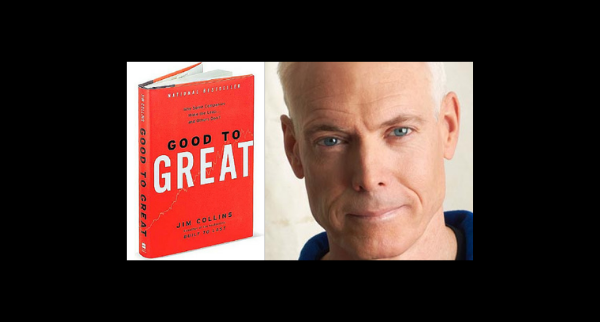Book Review #3: Good to Great by Jim Collins
Good to Great by Jim Collins is unarguably a classic, one of the best-selling business books of all time, and has sold over 4 million copies worldwide. The insights shared by Jim Collins are a result of the research conducted by his team over 5 years with 11 publicly traded companies, including Kimberley-Clark, Wells Fargo and Gillette, while also examining 1,435 Fortune 500 companies.
The purpose of the research was to explore the difference in behaviours between great companies and their peers. The book explores what choices, decisions, actions and disciplines separate the Good from the Great companies; the ones which systematically and consistently produced superior results.
The timeless principles introduced in the book are all derived from empirical evidence and illustrated by fascinating real leadership stories. While the book was based on studies from large organisations, the principles are relevant for leaders in any industry; from entrepreneurs, start-ups and small-medium business owners, to C-level executives in global firms.
My Top 7 Takeaways:
- Discipline is key | Disciplined People. Disciplined Thought. Disciplined Action.
- Homegrown CEO’s are best | The outside CEO saviour is a myth. Appointing a high-profile and well-known outside CEO is unlikely to have a determinant effect on the company achieving great results. Ten out of the eleven Good to Great CEOs came from inside the company. Collins shared a remarkable story about Darwin Smith, the low-key CEO from Kimberly-Clarke. He was the perfect example of a homegrown CEO who carried no air of self-importance or cultivated any hero or celebrity status, yet was responsible for a stunning turnaround during his own 25 year battle with cancer, thanks to his fierce and even stoic resolve.
- Technology Accelerators | Don’t rely on technology to create momentum. Avoid technology fads. Be mindful of the fear of being left behind. Technology projects must be carefully selected and aligned with the Hedgehog concept (see below).
- Mergers & Acquisitions are not the answer | M&A play virtually no role in igniting transformation. Little impact can be done via mergers and acquisitions prior to the hedgehog concept being well defined/established.
- BHAG | Short for “Big Hairy Audacious Goal”. A BHAG is a huge and dauting goal – like a mountain to climb – that serves as a unifying focal point of effort.
- STOP doing list | Stay focused on the Hedgehog concept and resist the shiny-object syndrome.
- The Stockdale Paradox | Retain faith that you will prevail in the end, regardless of the difficulties, and at the same time confront the most brutal facts of your current reality, whatever they might be.
7 Core Principles:
- Level 5 Leadership = Humility + Will | Level 5 leaders are characterised by their extreme personal humility, coupled with intense professional will. They are fanatically driven and have a ferocious resolve and almost stoic determination to do whatever is required (e. g. fire their own brother) to achieve great results. Usually modest, quiet and reserved, they do not have enormous egos and are more interested in seeking results than being put on a pedestal or becoming an icon. They are ambitious, however their drive is channelled towards the institution, not themselves. They are also invested in establishing a succession plan and setting up successors for success to ensure the company will continue to thrive after they are gone. Jim Collins mentioned Abraham Lincoln as a good example of a Level 5 leader.
- First Who, Then What | Get the right people on the bus, on the right seats, prior to looking into the strategy. When in doubt don’t hire; keep looking. Focus on removing non-performers (or those who are not a good fit) or moving them to other positions/projects within the organisation that better suits their skills. If a recruitment mistake is made, act immediately. Mantra – hire slow, fire fast. Put your best people on your biggest opportunities, not your biggest problems.
- Confront the Brutal Facts (Yet never lose faith) | Have the courage to face reality. Create a culture that enables individuals to speak up (psychological safety). Lead by asking questions; not providing answers. Develop insights by continuously communicating with the team. Encourage open group dialogue and healthy debate, without ever assigning blame. Conduct strategy autopsies and analyse failures to learn lessons.
- Discipline Culture | A culture in which people will take action consistent with the Hedgehog principle. A culture of discipline combined with an ethic of entrepreneurship makes hierarchy, bureaucracy and excessive controls redundant. Build a culture of freedom and responsibility within a defined framework. Do not invest in projects not aligned with the Hedgehog concept.
- The Hedgehog Concept (simplicity within the 3 circles) | This concept was inspired by an old Greek fable. Your Hedgehog can be found at the intersection of 3 factors: 1. What you are most passionate about; 2. What you can (not hope to!) be the best at; 3. A lucrative business model. According to Jim Collins, it may take years to find your Hedgehog. If you cannot be the best in the world at your core business, then your core business absolutely cannot form the basis of a great company. Once you find your Hedgehog, stick to doing what you are best at and avoid getting distracted or side-tracked.
- The Flywheel Effect | Success does not occur overnight. Level 5 leaders spend little time or energy motivating people or overseeing change. The motivation is created by the momentum and results. Maintain the set course and take action consistently until breakthrough occurs. There is no one single heroic effort. Avoid the Doom Loop, which is the opposite of the flywheel effect. Once you identify your Hedgehog Concept, avoid changing direction.
- Technology accelerators | Technology will not save a mediocre company from failing, nor can it take a good company and turn into a great one. It is not technological advancements but the selection and application of specific useful technologies that aid in the transition to greatness. Adopt technology only when it is sustainable, relevant and supports the Hedgehog concept.












Leave a Reply